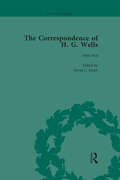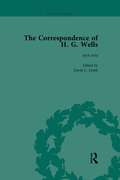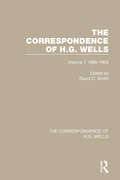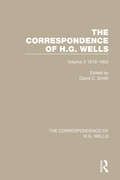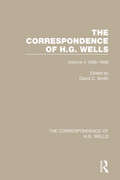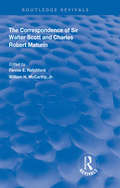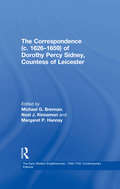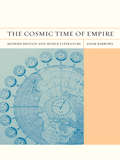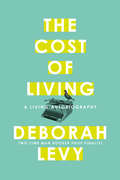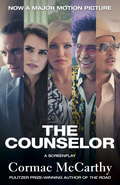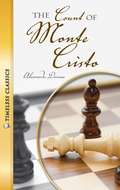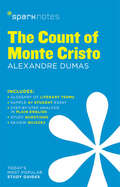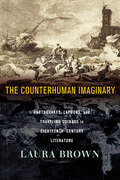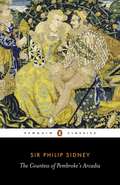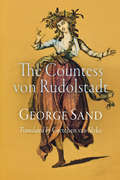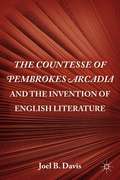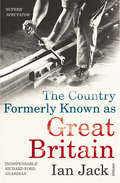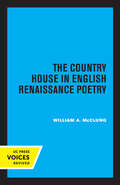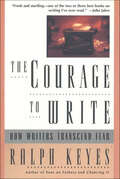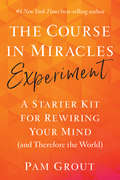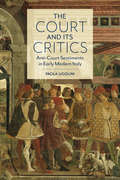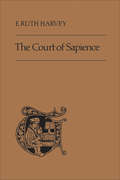- Table View
- List View
The Correspondence of H G Wells Vol 2
by Patrick Parrinder David Smith H G WellsThis collection of H.G. Wells's correspondence draws on over 50 archives and libraries worldwide, including the papers of Wells's daughter by Amber Reeves. The book contains over 2000 letters, both business and personal. Wells's private correspondence includes letters to Winston Churchill.
The Correspondence of H G Wells Vol 3
by Patrick Parrinder David Smith H G WellsThis collection of H.G. Wells's correspondence draws on over 50 archives and libraries worldwide, including the papers of Wells's daughter by Amber Reeves. The book contains over 2000 letters, both business and personal. Wells's private correspondence includes letters to Winston Churchill.
The Correspondence of H G Wells Vol 4
by Patrick Parrinder David Smith H G WellsThis collection of H.G. Wells's correspondence draws on over 50 archives and libraries worldwide, including the papers of Wells's daughter by Amber Reeves. The book contains over 2000 letters, both business and personal. Wells's private correspondence includes letters to Winston Churchill.
The Correspondence of H.G. Wells: Volume 1 1880–1903 (The Correspondence of H.G. Wells #1)
by David C. SmithThis collection of H.G. Wells's correspondence draws on over 50 archives and libraries worldwide, including the papers of Wells's daughter by Amber Reeves. The book contains over 2,000 letters, and while a few are business – to publishers, agents and secretaries – the majority are much more personal. Wells's private correspondence extends from letters to President Franklin Roosevelt and Prime Ministers Winston Churchill and A.J. Balfour, to persons such as ‘Mark Benney’, who wrote novels based on his life in the slums and his time in prison. There is correspondence too with his many female friends and lovers, among them Rebecca West, Eileen Power, Gertrude Stein, Marie Stopes, Lilah MacCarthy and Dorothy Richardson. For example, a letter from Moura Budberg, with whom Wells had a long-standing affair, which announces that she is pregnant by him and about to have an abortion, reveals how an advocate of birth control is himself caught out. Wells also enjoyed correspondence with the press, particularly during the two World Wars, and with various BBC officials and people who worked on his films. Some of his letters on the controversies of free love, socialism, birth control, the Fabian Society, and the nature of the curriculum of the new London University in the 1890s are included. Interspersed chronologically with Wells's letters is a small selection of about 40 letters to Wells, where letters from him are not extant. Among these are letters from Ray Lankester, Joseph Conrad, C.G. Jung, Trotsky, Hedy Gatternigg (the woman who attempted suicide in Wells's flat), and J.C. Smuts. The letters are arranged in these periods: Volume 1 1878–1900; Volume 2 1901–1912; Volume 3 1913–1930; and Volume 4 1930–1946. H.G. Wells's works include The Time Machine (1895), The Invisible Man (1897), The War of the Worlds (1898), The History of Mr Polly (1910), and A Short History of the World (1922).
The Correspondence of H.G. Wells: Volume 2 1904–1918 (The Correspondence of H.G. Wells #2)
by David C. SmithThis collection of H.G. Wells's correspondence draws on over 50 archives and libraries worldwide, including the papers of Wells's daughter by Amber Reeves. The book contains over 2,000 letters, and while a few are business – to publishers, agents and secretaries – the majority are much more personal. Wells's private correspondence extends from letters to President Franklin Roosevelt and Prime Ministers Winston Churchill and A.J. Balfour, to persons such as ‘Mark Benney’, who wrote novels based on his life in the slums and his time in prison. There is correspondence too with his many female friends and lovers, among them Rebecca West, Eileen Power, Gertrude Stein, Marie Stopes, Lilah MacCarthy and Dorothy Richardson. For example, a letter from Moura Budberg, with whom Wells had a long-standing affair, which announces that she is pregnant by him and about to have an abortion, reveals how an advocate of birth control is himself caught out. Wells also enjoyed correspondence with the press, particularly during the two World Wars, and with various BBC officials and people who worked on his films. Some of his letters on the controversies of free love, socialism, birth control, the Fabian Society, and the nature of the curriculum of the new London University in the 1890s are included. Interspersed chronologically with Wells's letters is a small selection of about 40 letters to Wells, where letters from him are not extant. Among these are letters from Ray Lankester, Joseph Conrad, C.G. Jung, Trotsky, Hedy Gatternigg (the woman who attempted suicide in Wells's flat), and J.C. Smuts. The letters are arranged in these periods: Volume 1 1878–1900; Volume 2 1901–1912; Volume 3 1913–1930; and Volume 4 1930–1946. H.G. Wells's works include The Time Machine (1895), The Invisible Man (1897), The War of the Worlds (1898), The History of Mr Polly (1910), and A Short History of the World (1922).
The Correspondence of H.G. Wells: Volume 3 1919–1934 (The Correspondence of H.G. Wells #3)
by David C. SmithThis collection of H.G. Wells's correspondence draws on over 50 archives and libraries worldwide, including the papers of Wells's daughter by Amber Reeves. The book contains over 2,000 letters, and while a few are business – to publishers, agents and secretaries – the majority are much more personal. Wells's private correspondence extends from letters to President Franklin Roosevelt and Prime Ministers Winston Churchill and A.J. Balfour, to persons such as ‘Mark Benney’, who wrote novels based on his life in the slums and his time in prison. There is correspondence too with his many female friends and lovers, among them Rebecca West, Eileen Power, Gertrude Stein, Marie Stopes, Lilah MacCarthy and Dorothy Richardson. For example, a letter from Moura Budberg, with whom Wells had a long-standing affair, which announces that she is pregnant by him and about to have an abortion, reveals how an advocate of birth control is himself caught out. Wells also enjoyed correspondence with the press, particularly during the two World Wars, and with various BBC officials and people who worked on his films. Some of his letters on the controversies of free love, socialism, birth control, the Fabian Society, and the nature of the curriculum of the new London University in the 1890s are included. Interspersed chronologically with Wells's letters is a small selection of about 40 letters to Wells, where letters from him are not extant. Among these are letters from Ray Lankester, Joseph Conrad, C.G. Jung, Trotsky, Hedy Gatternigg (the woman who attempted suicide in Wells's flat), and J.C. Smuts. The letters are arranged in these periods: Volume 1 1878–1900; Volume 2 1901–1912; Volume 3 1913–1930; and Volume 4 1930–1946. H.G. Wells's works include The Time Machine (1895), The Invisible Man (1897), The War of the Worlds (1898), The History of Mr Polly (1910), and A Short History of the World (1922).
The Correspondence of H.G. Wells: Volume 4 1935–1946 (The Correspondence of H.G. Wells #4)
by David C. SmithThis collection of H.G. Wells's correspondence draws on over 50 archives and libraries worldwide, including the papers of Wells's daughter by Amber Reeves. The book contains over 2,000 letters, and while a few are business – to publishers, agents and secretaries – the majority are much more personal. Wells's private correspondence extends from letters to President Franklin Roosevelt and Prime Ministers Winston Churchill and A.J. Balfour, to persons such as ‘Mark Benney’, who wrote novels based on his life in the slums and his time in prison. There is correspondence too with his many female friends and lovers, among them Rebecca West, Eileen Power, Gertrude Stein, Marie Stopes, Lilah MacCarthy and Dorothy Richardson. For example, a letter from Moura Budberg, with whom Wells had a long-standing affair, which announces that she is pregnant by him and about to have an abortion, reveals how an advocate of birth control is himself caught out. Wells also enjoyed correspondence with the press, particularly during the two World Wars, and with various BBC officials and people who worked on his films. Some of his letters on the controversies of free love, socialism, birth control, the Fabian Society, and the nature of the curriculum of the new London University in the 1890s are included. Interspersed chronologically with Wells's letters is a small selection of about 40 letters to Wells, where letters from him are not extant. Among these are letters from Ray Lankester, Joseph Conrad, C.G. Jung, Trotsky, Hedy Gatternigg (the woman who attempted suicide in Wells's flat), and J.C. Smuts. The letters are arranged in these periods: Volume 1 1878–1900; Volume 2 1901–1912; Volume 3 1913–1930; and Volume 4 1930–1946. H.G. Wells's works include The Time Machine (1895), The Invisible Man (1897), The War of the Worlds (1898), The History of Mr Polly (1910), and A Short History of the World (1922).
The Correspondence of Sir Walter Scott and Charles Robert Maturim (Routledge Revivals)
by Fannie E. Ratchford William H. McCarthyOriginally published in 1937, The Correspondence of Sir Walter Scott and Charles Robert Maturin contains twenty-two letters presenting a penetrating and vivid self-portrait of Sir Walter Scott. Scott's patronage of Maturin, this impecunious Irish author, giving him wise advice, lending encouragement in his work and at times badly needed financial assistance, extended over a period of twelve years to the time of Maturin's death, and his kind subsequent letters, written to Maturin's family, in the midst of his own great financial troubles, bring to a fitting close this single unit in Scott's rich social life. Since the two men never met, the whole relationship was built up through thier literary work and their letters to each other, displayed in this volume.
The Correspondence: The Correspondence (1588-1621) Of Robert Sidney, First Earl Of Leicester, And Barbara Gamage Sidney, Countess Of Leicester (The Early Modern Englishwoman, 1500-1750: Contemporary Editions)
by Michael G. Brennan Noel J. KinnamonThe letters of Dorothy Percy Sidney, Countess of Leicester, dating predominantly from about 1636 until 1643, cover a wide range of issues and vividly illustrate her centrality to her illustrious family's personal and public affairs. These c.100 letters are here for the first time fully transcribed and edited. The edition includes a biographical and historical introduction, setting the context of the Sidneys' family and political activities at the time of Dorothy's marriage to Robert in 1615 and then tracing the major events and involvements of her life until her death in 1659. A key to the cipher used in the letters to disguise identities of individuals is also supplied. Following the introduction is the complete text of each of Dorothy Percy Sidney's letters to her husband, Robert, second Earl of Leicester, and to and from William Hawkins, the Sidney family solicitor, along with several others, including letters from Dorothy to Archbishop Laud and the Earl of Holland. Her husband's account of her last moments in 1659, and testamentary directions relating to her will, are also included. The letters are arranged in chronological order and supported by a series of footnotes that elucidate their historical context and briefly to identify key individuals, places, political issues and personal concerns. These notes are further supported by selective quotations from Dorothy's incoming correspondence and other related letters and documents. A glossary supplies more detailed information on 'Persons and Places.' Dorothy Percy Sidney's letters eloquently convey how, even with her undoubted personal potency and shrewd intelligence, the multifaceted roles expected of an able and determined aristocratic early modern Englishwoman-especially when her husband was occupied abroad on official business-were intensely demanding and testing.
The Cosmic Time of Empire: Modern Britain and World Literature
by Adam BarrowsCombining original historical research with literary analysis, Adam Barrows takes a provocative look at the creation of world standard time in 1884 and rethinks the significance of this remarkable moment in modernism for both the processes of imperialism and for modern literature. As representatives from twenty-four nations argued over adopting the Prime Meridian, and thereby measuring time in relation to Greenwich, England, writers began experimenting with new ways of representing human temporality. Barrows finds this experimentation in works as varied as Victorian adventure novels, high modernist texts, and South Asian novels--including the work of James Joyce, Virginia Woolf, H. Rider Haggard, Bram Stoker, Rudyard Kipling, and Joseph Conrad. Demonstrating the investment of modernist writing in the problems of geopolitics and in the public discourse of time, Barrows argues that it is possible, and productive, to rethink the politics of modernism through the politics of time.
The Cosmic Web: Scientific Field Models and Literary Strategies in the Twentieth Century
by N. Katherine HaylesFrom the central concept of the field—which depicts the world as a mutually interactive whole, with each part connected to every other part by an underlying field— have come models as diverse as quantum mathematics and Saussure’s theory of language. In The Cosmic Web, N. Katherine Hayles seeks to establish the scope of the field concept and to assess its importance for contemporary thought. She then explores the literary strategies that are attributable directly or indirectly to the new paradigm; among the texts at which she looks closely are Robert Pirsig’s Zen and the Art of Motorcycle Maintenance, Nabokov’s Ada, D. H. Lawrence’s early novels and essays, Borges’s fiction, and Thomas Pynchon’s Gravity’s Rainbow.
The Cost of Living: A Working Autobiography
by Deborah LevyCrystalline, witty and audacious, The Cost of Living addresses itself to the dual experiences of writing and of womanhood, examining what is essential in each. Following the acclaimed Things I Don't Want to Know, which reflected deeply on the nature of gender politics and a life in letters, The Cost of Living returns to the same subject and to the same life, to find a writer in radical flux. If a woman dismantles her life, expands it and puts it back together in a new shape, how might she describe this new composition? "Words have to open the mind. When words close the mind you can be sure that someone has been reduced to nothingness." <p><p> In this elegiac second instalment of her "living autobiography", Deborah Levy considers what it means to live with value and meaning and pleasure. The Cost of Living is a vital and astonishing testimony, as distinctive, wide-ranging and original as Levy's acclaimed novels.
The Counselor: A Screenplay (Vintage International)
by Cormac MccarthyOn the eve of becoming a married man, the Counselor makes a risky entrée into the drug trade--and gambles that the consequences won't catch up to him. Along the gritty terrain of the Texas-Mexico border, a respected and recently engaged lawyer throws his stakes into a cocaine trade worth millions. His hope is that it will be a one-time deal and that, afterward, he can settle into life with his beloved fiancée. But instead, the Counselor finds himself mired in a brutal and dangerous game--one that threatens to destroy everything and everyone he loves. Deft, shocking, and unforgettable, McCarthy is at his finest in this gripping tale about risk, consequence, and the treacherous balance between the two.
The Count Of Monte Cristo (Timeless Classics Ser.)
by Alexandre Dumas Stephen FeinsteinOn the night before his wedding, an innocent young man is arrested and imprisoned. How could such a thing have happened? When he finally discovers the truth, he bitterly plots revenge. Then he escapes of prison and begins to punish his enemies, one by one. <P><P>Timeless Classics designed for the struggling reader and adapted to retain the integrity of the original classic. These classic novels will grab a students attention from the first page. Included are eight pages of end-of-book activities to enhance the reading experience.
The Count of Monte Cristo SparkNotes Literature Guide (SparkNotes Literature Guide Series #22)
by Alexandre Dumas SparkNotesSparkNotes Literature Guides:Making the reading experience fun! When a paper is due, and dreaded exams loom, heres the lit-crit help students need to succeed! SparkNotes Literature Guides make studying smarter, better, and faster. They provide chapter-by-chapter analysis; explanations of key themes, motifs, and symbols; a review quiz; and essay topics. Lively and accessible, SparkNotes is perfect for late-night studying and paper writing. Includes:An A+ Essay—an actual literary essay written about the Spark-ed book—to show students how a paper should be written.16 pages devoted to writing a literary essay including: a glossary of literary termsStep-by-step tutoring on how to write a literary essayA feature on how not to plagiarize
The Counterhuman Imaginary: Earthquakes, Lapdogs, and Traveling Coinage in Eighteenth-Century Literature
by Laura BrownThe Counterhuman Imaginary proposes that alongside the historical, social, and institutional structures of human reality that seem to be the sole subject of the literary text, an other-than-human world is everywhere in evidence. Laura Brown finds that within eighteenth-century British literature, the human cultural imaginary can be seen, equally, as a counterhuman imaginary—an alternative realm whose scope and terms exceed human understanding or order.Through close readings of works by Daniel Defoe, Jonathan Swift, and Alexander Pope, along with lapdog lyrics, circulation narratives that give agency to inanimate objects like coins and carriages, and poetry about the Lisbon earthquake of 1755, Brown traces the ways presence and power of the nonhuman—weather, natural disasters, animals, even the concept of love—not only influence human creativity, subjectivity, and history but are inseparable from them. Traversing literary theory, animal studies, new materialism, ecocriticism, and affect theory, The Counterhuman Imaginary offers an original repudiation of the centrality of the human to advance an integrative new methodology for reading chaos, fluidity, force, and impossibility in literary culture.
The Countess of Pembroke's Arcadia (C Oet T Oxford English Texts)
by Philip SidneyBasilus, a foolish old duke, consults an oracle as he imperiously wishes to know the future, but he is less than pleased with what he learns. To escape the oracle's horrific prophecies about his family and kingdom he withdraws into pastoral retreat with his wife and two daughters. When a pair of wandering princes fall in love with the princesses and adopt disguises to gain access to them, all manner of complications, both comic and serious, ensue. Part-pastoral romance, part-heroic epic, Sidney's long narrative work was hugely popular for centuries after its first publication in 1593, inspiring two sequels and countless imitations, and contributing greatly to the development of the novel.
The Countess von Rudolstadt
by George Sand Gretchen Van SlykeThe first translation of The Countess von Rudolstadt in more than a century brings to contemporary readers one of George Sand's most ambitious and engaging novels, hailed by many scholars of French literature as her masterpiece. Consuelo, or the Countess von Rudolstadt, born the penniless daughter of a Spanish gypsy, is transformed into an opera star by the great maestro Porpora. Her peregrinations throughout Europe (especially Vienna, Berlin, and the Bohemian forest), become a quest undertaken on a number of levels: as a singer, as a woman, and as an unwilling subject of alienation and oppression.Sand's heroine moves through a mid-eighteenth-century Europe where absolute rulers mingle with Enlightenment philosophers and gender-bending members of secret societies plot moral and political revolution. As the old order breaks down, she undergoes a series of grueling initiations into radically redefined notions of marriage and social organization. In a novel by equal measures philosophical and lurid, nothing is what it seems. Written some fifty years after the French Revolution, the book taps into many of the political and religious currents that contributed to that social upheaval—and aims to channel their potential for future change.Fed by Sand's rich imagination and bold aspirations for social reform, The Countess von Rudolstadt is a sinuous novel of initiation, continuing the coming of age tale of the titular heroine of Sand's earlier Consuelo and drawing on such diverse models as Ann Radcliffe's Gothic tales and Goethe's Wilhelm Meister.
The Countesse of Pembrokes Arcadia and the Invention of English Literature
by Joel B. DavisRevises the semiotic paradigm of the early modern 'literary system' dominant since 1983 by adapting methods entailed in the idea that literary works emerge through a series of semiotic events. Davis analyzes Philip Sidney's Arcadia and Astrophil and Stella to demonstrate how design elements stage the scene of reading these works.
The Country Formerly Known as Great Britain
by Ian JackIn this selection from over twenty years of reporting and writing, Ian Jack sets out to deal with contemporary Britain - from national disasters to football matches to obesity - but is always drawn back in time, vexed by the question of what came first. In 'Women and Children First', watching the film Titanic leads into an investigation into the legend of Wallace Henry Hartley, the famous band leader of the doomed liner, while 'The 12.10 to Leeds', a magnificent report on the Hatfield rail crash, begins its hunt for clues in the eighteenth century in the search for those responsible. Further afield, he finds vestiges of a vanished Britain in the Indian subcontinent, meeting characters like maverick English missionary and linguist William Carey, credited with importing India's first steam engine.Full of the style, knowledge and intimacy that makes his work so special, this collection is the perfect introduction to the work of one of the country's finest writers.
The Country House in English Renaissance Poetry
by William Alexander McClungThis title is part of UC Press's Voices Revived program, which commemorates University of California Press’s mission to seek out and cultivate the brightest minds and give them voice, reach, and impact. Drawing on a backlist dating to 1893, Voices Revived makes high-quality, peer-reviewed scholarship accessible once again using print-on-demand technology. This title was originally published in 1977.
The Courage to Write: How Writers Transcend Fear
by Ralph KeyesThe Courage to Write is an invaluable book and essential reading for anyone who wishes to learn how to write well.Katherine Anne Porter called courage "the first essential" for a writer. "I have to talk myself into bravery with every sentence," agreed Cynthia Ozick, "sometimes every syllable." E. B. White said he admired anyone who "has the guts to write anything at all."An author who has taught writing for more than thirty years,In The Courage to Write, Ralph Keyes, an author who has taught writing for more than thirty years, assures us that anxiety is felt by writers at every level, especially when they dare to do their best. He describes the sequence of "courage points" through which all writers must pass, from the challenge of identifying a worthwhile project to the mixture of pride and panic they feel when examining a newly published book or article. Keyes also offers specifics on how to root out dread of public "performance" and of the judgment of family and friends, make the best use of writers' workshops and conferences, and handle criticism of works in progress. Throughout, he includes the comments of many accomplished writers -- Pat Conroy, Amy Tan, Rita Dove, Isabel Allende, and others -- on how they transcended their own fears to produce great works.
The Course in Miracles Experiment: A Starter Kit for Rewiring Your Mind (and Therefore the World)
by Pam GroutACIM, the Fun Version! A real-world rewrite of the lessons of A Course in Miracles by the #1 New York Times best-selling author of E-Squared.A Course in Miracles is profound, deeply moving, and as boring to read as a bookshelf assembly manual.Ask for a show of hands at any self-help gathering, and 95 percent will happily admit to owning the dense blue book that's a famous resource for spiritual transformation. Ask the obvious follow-up, "How many have actually read it?" and all but a smattering of hands go down. It's as if everyone wants the miracles, the forgiveness, and the mind shifts, but they just can't bear its ponderous heaviness. Pam Grout to the rescue! Her new book is for all those still struggling with the Course. Grout offers a modern-day rewrite of the 365-lesson workbook-the text at the heart of the Course. Unlike the original, it's user-friendly, accessible and easy for everyone to understand.In daily lessons with titles like "The Home Depot of Spiritual Practices" and "Transcending the Chatty Asshat in My Head," Grout drills down to the Course's essential message and meaning, grounding it in the context of everyday life in a way that's bound to stick. The lessons here blend eternal truths with pop culture and personal stories that are laugh-out-loud funny and deeply soul-stirring, often at the same time. You won't be tempted to use this Course in Miracles as a doorstop. You'll want to use it, every day, to change your life.
The Court and Its Critics: Anti-Court Sentiments in Early Modern Italy (Toronto Italian Studies)
by Paola UgoliniAnti-courtly discourse furnished a platform for discussing some of the most pressing questions of early modern Italian society. The court was the space that witnessed a new form of negotiation of identity and prestige, the definition of masculinity and of gender-specific roles, the birth of modern politics and of an ethics based on merit and on individual self-interest. The Court and Its Critics analyzes anti-courtly critiques using a wide variety of sources including manuals of courtliness, dialogues, satires, and plays, from the mid-fifteenth to the early seventeenth century. The book is structured around four key figures that embody different features of anti-courtly sentiments. The figure of the courtier shows that sentiments against the court were present even among those who apparently benefitted from such a system of power. The court lady allows an investigation of the intertwining between anti-courtliness and anti-feminism. The satirist and the shepherd of pastoral dramas are investigated as attempts to fashion two different forms of a new self for the court intellectual.
The Court of Sapience
by Elizabeth Ruth HarveyThe medieval English allegorical poem, The Court of Sapience, was written in the middle of the fifteenth century by an unknown author. It is best described as an encyclopaedia: in the allegory the poet describes the nature and activities of wisdom in all its aspects. He includes a moving account of the fall of a man and his restoration by divine wisdom; then he leads his dreamer through a landscape where all the traditional beauties of nature are catalogued and assigned their properties. The visit to the castle of Sapience, inhabited by all the branches of learning and the seven restorative virtues, completes the poem as we have it. The first edition was an early production of Caxton's press, and it was reprinted by his successor, Wynkyn de Worde. This is a new edition of Caxton's text of the poem. Variant readings from the extant manuscripts have investigated in detail and are discussed in the lengthy introduction and extensive commentary. The poem is an attractive work in itself, and has been admired by C.S. Lewis and other modern critics. It is also a valuable witness to the taste of the early Tudor period.
